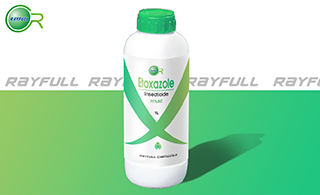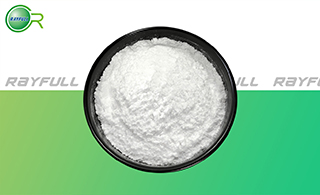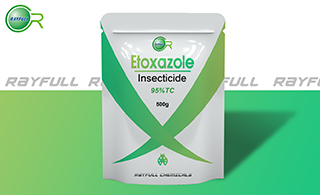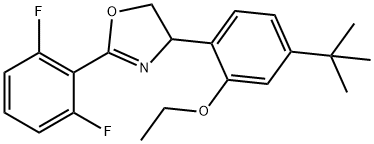Etoxazole
    ТТтэЯт ТТтэЯт
Introduction: Etoxazole is a narrow spectrum systemic acaricide used to combat spider mites. It targets a variety of mites in the egg, larvae and nymph stages however not the adult stage. It also exhibits insecticidal activity towards aphids, the green rice leafhopper and diamondback moth. The mode of action was originally suspected to inhibit the molting process but has since been shown to inhibit chitin synthesis. Resistance due to its high efficacy and cross resistance when used with other acaricides are both of concern similar to was seen in the fast development of cross resistance in the previous generation of acaricides. The LC50 for resistant mite strains has been observed over 100,000 times greater than that of susceptible strains. Thus resistance management strategies are important in order to limit the increase of etoxazole resistant mite strains.
Common name: Etoxazole
Another name: 4-(4-(tert-Butyl)-2-ethoxyphenyl)-2-(2,6-difluorophenyl)-4,5- dihydrooxazole; Baroque; Borneo; TetraSan; etc.
Chemical name: (RS)-5-tert-butyl-2-[2-(2,6-difluorophenyl)-4,5-dihydro-1,3-oxazol-4-yl]phenetole
Empirical formula: C21H23F2NO2
Structural formula:

Mol. Weight: 359.42 g/mol
CAS No.: 153233-91-1
Specifications
Leading Etoxazole supplier
Etoxazole 95% TC
Etoxazole 11% SC
Packing:
BULK PACKING
Powder: 25kg/Bag, 25kg/Drum, 50kg/Drum etc.
Liquid: 200L/Drum, 20L/Drum, 10L/Drum etc.
SMALL PACKING
Powder: 1kg/Alu bag, 500g/Alu bag, 200g/Alu bag, 100g/Alu bag, 50g/Alu bag, 15g/Alu bag etc.
Liquid: 5L/Drum, 1L/Bottle, 500ml/Bottle, 250ml/Bottle, 100ml/Bottle, 50ml/Bottle etc.
Customerized packing label
Etoxazole FAO standard
Professional registration
HAZARDS IDENTIFICATION
Hazard statement(s)
H400 (100%): Very toxic to aquatic life.
H410 (41.46%): Very toxic to aquatic life with long lasting effects.
Precautionary statement(s)
P273: Avoid release to the environment.
P391: Collect spillage.
P501: Dispose of contents/container to.
Supplemental Hazard Statements: none.
MAMMALIAN TOXICOLOGY
Acute toxicity: 1) Acute oral LD50 for rats is >5000 mg/kg. 2) Acute dermal LD50 for rats is >2000 mg/kg. 3) Acute inhalation toxicity LC50 (4 h) for rats is >1.09 mg/L. 4) Skin irritation: Non-irritating to skin (rabbits). 5) Eye irritation: Non-irritating to eyes (rabbits). 6) Skin sensitization for guinea pig: Non-sensitizer.
NOEL: (2 y) for rats is 64 mg/kg/day, (2 y) for mice is 242 mg/kg/day, (1 y) for dogs is 5.33 mg/kg/day. Other Not carcinogenic. Not genotoxic.
ADI (JMPR) 0-0.01 mg/kg b.w. [2006]
Classification:
WHO Classification: NL (Not listed)
EC Risk Classification: N - Dangerous for the environment: R50, R53
US EPA Classification (formulation): No consensus across products or no products available
ECOTOXICOLOGY
Effect on birds: Acute oral LD50 (8 d) for Mallard is >2000 mg/kg. Effect on fish: Acute LC50 (96 h) for Rainbow trout is 2.8 mg/l. Effects on aquatic invertebrates: Acute EC50 (48 h) for Daphnia magna is 0.0071 mg/l. Effects on algae: Acute 72 hour EC50 for Raphidocelis subcapitata is >10 mg/l. Effects on bees: Contact acute 48 hour LD50 is >200 ҰМg/bee, oral acute 48 hour LD50 is >200 ҰМg/bee. Effects on earthworms: Acute 14 day LC50 is >1000 mg/kg.
ENVIRONMENTAL FATE
If released to air, a vapor pressure of 1.64ЎБ10-8 mm Hg at 25Ўж indicates etoxazole will exist solely in the particulate phase in the ambient atmosphere. Particulate-phase etoxazole will be removed from the atmosphere by wet and dry deposition. If released to soil, etoxazole is expected to have no mobility based upon Koc values of greater than 5,000. Volatilization from moist soil surfaces is not expected to be an important fate process based upon an estimated Henry's Law constant of 1.0ЎБ10-7 atm-cu m/mole. Etoxazole is not expected to volatilize from dry soil surfaces based upon its vapor pressure. The mean of seven half-life values for the biodegradation of etoxazole in a variety of soils was reported as 20.5 days. If released into water, etoxazole is expected to adsorb to suspended solids and sediment based upon Koc values greater than 5,000. Etoxazole is expected to be biodegraded in water based on a mean half-life of 20.5 days in soil. Volatilization from water surfaces is not expected to be an important fate process based upon this compound's estimated Henry's Law constant. An estimated BCF of 10,000 suggests the potential for bioconcentration in aquatic organisms is very high. Etoxazole is considered to be degraded under acidic conditions, but stable at pH 7-9. This substance was reported to be degraded in approximately 10 days at pH 5.
Usage: Etoxazole was discovered by Yashima Chemical Industry Co., Ltd. It is an insecticide for use in the field and in the glasshouse, on, for example, pome fruits, cotton and vegetables to control phytophagous mites.
Application: Mode of action Contact acaricide. Appears to inhibit moulting of mites and aphids. Uses Non-systemic acaricide with effect on eggs, larvae and nymphs, with no effect on adults. Controls many phytophagous mites (Tetranychus, Panonychus spp.) in citrus, pome fruit, vegetables and strawberries, at 50 g/ha, and in tea, at 100 g/ha.
| 






